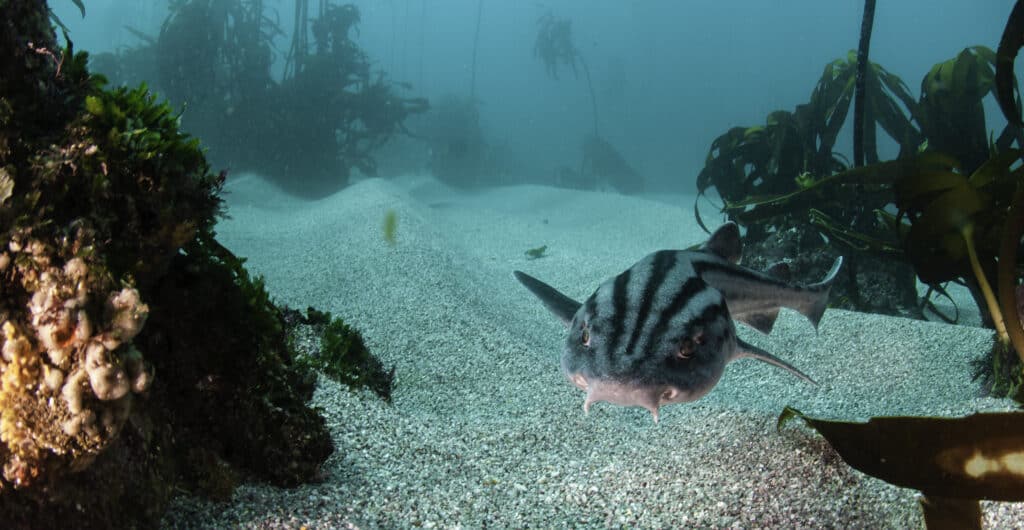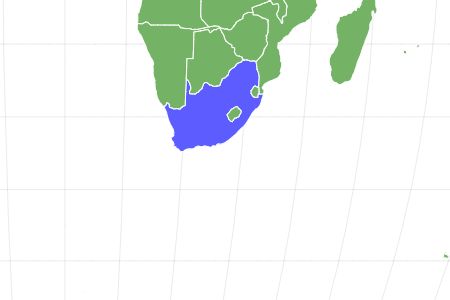Pyjama Shark
Poroderma africanum
Pyjama Sharks like to swim in shallow inshore waters.
Advertisement
Pyjama Shark Scientific Classification
- Kingdom
- Animalia
- Phylum
- Chordata
- Class
- Chondrichthyes
- Order
- Carcharhiniformes
- Family
- Scyliorhinidae
- Genus
- Poroderma
- Scientific Name
- Poroderma africanum
Read our Complete Guide to Classification of Animals.
Pyjama Shark Conservation Status
Pyjama Shark Facts
- Prey
- Smaller sharks, bony fish, octopus, squid
- Main Prey
- Octopus and squid
- Name Of Young
- Pup
- Group Behavior
- Sociable
- Fun Fact
- Pyjama Sharks like to swim in shallow inshore waters.
- Biggest Threat
- Larger sharks
- Most Distinctive Feature
- Stripes
- Other Name(s)
- Striped Catfish
- Incubation Period
- 5.5 months
- Litter Size
- 1
- Habitat
- Inshore ocean
- Predators
- Larger sharks
- Diet
- Carnivore
- Lifestyle
- Nocturnal
- Social
- Favorite Food
- Octopus and Squid
- Type
- Catshark
- Common Name
- Striped Catshark
- Number Of Species
- 1
- Location
- South Africa
View all of the Pyjama Shark images!
This striped Pyjama shark is native to the shallow coastal waters of South Africa.
The stripes of the Pyjama Shark give them the appearance of striped pajamas. They are still distinctive and interesting ocean creatures. These sharks are popular in aquariums due to their striped appearance. This helps people learn more about them as well as their natural environment, their behavior, and where they fit into the larger ecosystem.
5 Pyjama Shark Facts
- Pyjama Sharks usually stay near the ocean floor.
- These sharks like to swim in shallow inshore waters.
- Their favorite foods are octopus and squid.
- They can grow up to 3.5 feet long.
- They actually ambush some of their prey, specifically the chokka squid that comes down to the ocean floor to attach its eggs to egg beds where the Pyjama Sharks wait.
Classification and Scientific Name
The scientific name of Pyjama Sharks is Poroderma africanum. They are also sometimes called Striped Catsharks. They are part of the catshark family Scyliorhinidae. These sharks were discovered and named in 1789, eventually becoming the type species for their genus, Poroderma.
They belong to the Carcharhiniformes order, which is the largest group of sharks. Also known as ground sharks, this order includes hammerhead sharks and hound sharks. All sharks, including the Pyjama Shark, are part of the Selachimorpha superorder. Sharks are characterized by skeletons made primarily of cartilage, five to seven gills on each side, and pectoral fins that are not connected to their heads.
Pyjama Sharks are part of the Chondrichthyes class that includes all cartilage skeleton fish. They are part of the Chordata phylum and Animalia kingdom.
Pyjama Shark Appearance
No, these sharks don’t wear pajamas all day. They can grow as large as 3.5 feet long and 15-17 pounds. Their heads are short and a little bit flat at the snout. The majority of their body is taken up by their midsection.
They do have nictitating membranes on their eyes. This means that they have a third translucent clear eyelid that can go over their eye as they swim. These membranes offer protection as well as keep their eyes moist. Many other sharks and fish exhibit the same trait.
Interestingly, their upper teeth are visible even when their mouth is closed. Pyjama Sharks have between 18 and 25 teeth and 14 and 24 teeth in two rows on either side of their head. That’s a lot of teeth! They use these to eat small fish, small sharks and rays, and even crabs and crustaceans. Each one of their teeth has three points, one large one in the middle and two smaller ones on each side.
In appearance, they are grey or brown with horizontal stripes running down their body. Their stripes break around their tail as well as near their eyes. They have lighter underbellies, which can also have slight speckling. Their stripes are one of the easiest ways to recognize this fish if you see it in the ocean.

Pyjama sharks swim close to the ocean floor.
©wildestanimal/Shutterstock.com
Distribution, Population, and Habitat
Pyjama Sharks live off the coast of South Africa in temperate saltwater areas. It favors the Western Cape and is often seen there swimming in shallow inshore waters. They like to swim along the bottom of the ocean and in underwater kelp forests. They do prefer shallow waters, usually around 5 or 6 feet deep. But some areas, such as Algoa Bay, have water that is as deep as 300 feet and sharks also live there.
These sharks are not endangered and live unencumbered in the coastal waters around South Africa. They do not interact with or get aggressive with humans in the wild. They are smaller sharks so people often do not see them and these sharks tend to keep their distance anyway. They are popular in aquariums, which do a lot to conserve and educate.
Within its typical range, there are multiple marine reserves and protected areas. This helps Pyjama Sharks as well as other species live and reproduce without their habitat being limited or threatened.
Where to find: Pyjama Sharks and How to Catch Them
Most fishermen do not actively look for or fish for Pyjama Sharks. They do get caught as bycatch but are often tossed back. Some people cut up the shark as bait for other species of fish and lobster. If you do want to fish for Pyjama Sharks, look in the shallow waters of bays in South Africa. The Western Cape is the area where they are most plentiful. Other popular areas to see them include Saldanha Bay, Table Bay, East London, and KwaZulu-Natal.
Pyjama Shark Predators and Prey
As one of the smaller sharks, Pyjama Sharks can be a tasty meal for other larger sharks. These large sharks also eat other smaller fishes and sharks. These sharks make up an important part of their ecosystem and food chain.
What eats Pyjama Shark?
Larger sharks in the same waters eat Pyjama Sharks. One of their most common predators is the Broadnose Sevengill Shark. These sharks go after adult Pyjama Sharks as well as juveniles. When threatened, the shark will curl into itself to try and protect its head.
Some other ocean animals eat Pyjama Shark eggs. Some whelks, or sea snails, pierce the outer shell of the egg and eat the yolk inside.
Humans are not a significant threat to Pyjama Sharks. However, many fishermen see them as a nuisance that goes after their catch. To combat this, some fishermen catch and kill them when they can. They do not do so in large enough numbers to negatively impact their population, though.
What do Pyjama Sharks eat?
Pyjama Sharks eat small bony fishes, including anchovies and gurnards. They do eat smaller sharks and even rays when they can. They show a preference for mollusks, such as octopus, squid, and cuttlefish. However, they are opportunistic eaters and will chow down on whatever prey is available.
These sharks are nocturnal and eat mostly during the night. They rest on the ocean floor for most of the day. This does deviate occasionally, especially when they have prey come near. They also change their habits to going after the chokka squid, one of their favorite meals.
One of the most interesting feeding habits that Pyjama Sharks exhibit is ambushing their prey. This happens most often with a species of squid that lives in the South African waters. The sharks wait on the ocean floor in the egg beds, waiting for the female squids to come down to lay eggs. When they do, the shark goes after the squid and makes a tasty meal of her. Pyjama sharks have been known to twist tentacles off both squid and octopus.
Reproduction and Lifespan
Female Pyjama Sharks lay eggs that hatch into baby Pyjama Sharks. Eggs are around 3.7 inches long and dark brown. The mother Pyjama Shark uses tendrils to attach them to the ocean floor where they mature. In captivity, scientists have seen the egg incubation period last just over 5 months.
Newly hatched Pyjama Sharks are around 5.5-5.9 inches long. They grow throughout their lifetime to an adult size of 35 inches long and larger. They are able to reproduce when they reach 31-33 inches long.
Pyjama Shark in Fishing and Cooking
Most fishermen do not actively fish for these sharks. The ones that do are mostly trying to get rid of animals that they consider pests. This is due to Pyjama Sharks going after other more desirable catches before the fishermen can reel them in. Some do catch them and use them for bait.
The shark is edible but rarely used in cooking. Skinning sharks are usually difficult but important to make sure that the flavor is good. If you do decide to try them, make sure that it is allowed in the area. Frying is always a good way to eat fish in a fish and chips dish.
RELATED LINKS:
See a Great White Shark Attack a Drone
Pacific Sleeper Shark
What do Bala Sharks Eat?
Thank you for reading! Have some feedback for us? Contact the AZ Animals editorial team.
Sources
- Save Our Seas, Available here: https://saveourseas.com/worldofsharks/species/pyjama-shark
- Two Oceans Aquarium, Available here: https://www.aquarium.co.za/blog/entry/pyjama-shark
- Shark Research Institute, Available here: https://www.sharks.org/pyjama-shark-poroderma-africanum

















